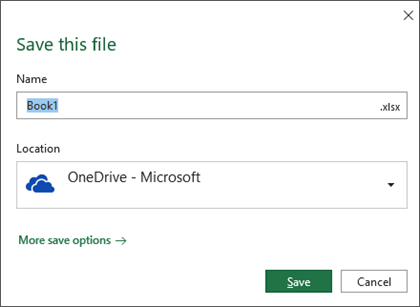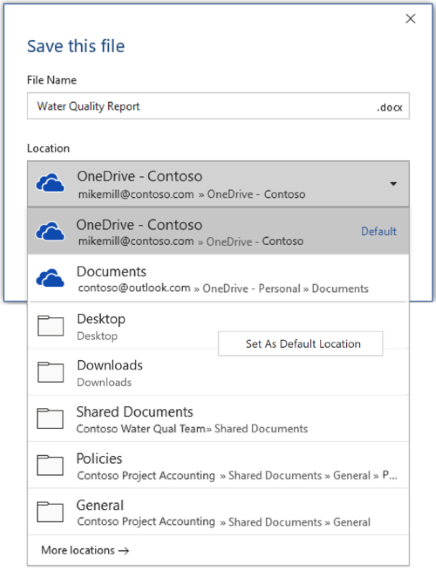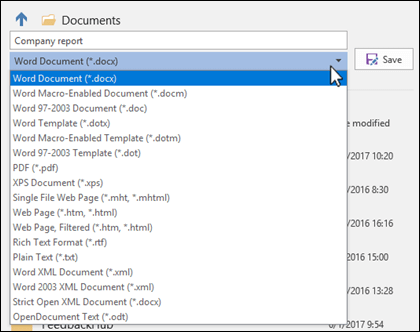Professional Folder, Downloads, Sourvenir, Email, Tabs, Submit Apps UPDATED
Professional Folder, Downloads, Sourvenir, Email, Tabs, Submit Apps
You lot can salvage a file to a folder on your difficult disk bulldoze, a network location, the cloud, a DVD, the desktop, or a wink drive. While you must identify the destination, if it is dissimilar than the default binder, the saving process is the aforementioned regardless of what destination you cull. By default, Office programs salve files in the default working folder.
Additionally you can save a file in a unlike file format, such as RTF, CSV, or PDF.
Saving a file to OneDrive or SharePoint allows you to access it on any device and enables features such as AutoSave and Version History, which can assist prevent data loss if your file closes unexpectedly.
To save your file:
-
Printing CTRL+S or select File >Save.
Tip:You can also select Save
 on the Quick Access Toolbar.
on the Quick Access Toolbar. -
Yous must enter a proper name for the file if you are saving it for the first time.
Tip:Save your file to a cloud location, such as OneDrive or SharePoint, to be able to admission it anywhere, interact with others in real-fourth dimension, and access Version History.
By default, if you're signed in, files are saved to your OneDrive. If yous want to salve the current file somewhere else, click the Location driblet-downward to encounter additional recently-used locations. If the location you lot want isn't there, you tin can open the total Relieve As window by selecting More than save options.

Tip:If y'all salve your file to OneDrive or SharePoint, AutoSave will be enabled by default, so yous don't take to remember to save as you become.
If you'd like to change the default location for these saves to one of your other recently-used folders, select the Location drop-downwards, right-click the binder location y'all want to ready as the default and select Set every bit Default Location.

If y'all want to save to a location other than your recently-used folders, select More than locations. If you haven't received this update yet, your Role applications will proceed to use the File menu for saving.
Tips:
-
You tin can likewise printing F12 or select File > Save As to open the File menu.
-
If you're used to using keyboard shortcuts when endmost your document, such as ALT+F4, you can rapidly choose to "Don't Salve" the file by using the keyboard accelerator key for that push button (ALT+N).
Save a copy every bit a new file (Save As)
Tip:If you're going to create a new file based on an existing file, but only want your changes saved in the new file, it's a good idea to Relieve a Copy before you've fabricated any changes. That style your original file will remain unchanged and all your edits will be in the new copy. You tin also right-click the original file and select Open up a copy.
-
Press F12 or click File > Save a Copy
-
By default Part will save the copy in the same location as the original. If you're happy with the existing location get on to pace 3. If you want to relieve the new copy in a different location choose it at this point.
Location
Clarification
Sites – [Your Company Proper noun]
SharePoint or Function 365 Groups document libraries
OneDrive – [Your Visitor Proper name]
OneDrive for Business concern
OneDrive – Personal
OneDrive for consumers via your Microsoft account
This PC
Your local device, including any connected hard drives or flash drives
Browse
Opens the File Explorer and then you tin can navigate to whatever location on your estimator.
-
Requite your new copy a proper noun and click Save.
Your original file will be airtight and you'll at present be working in the new copy yous just created.
Tip:If you observe yourself creating new files based on existing files oft, you may want to use templates to make the process easier and safer. See Create a template for more than information.
Save every bit a different format
You might want to save your file in some other format and so that yous, or somebody else, tin open the file in a different program or older version. For example, yous might want to salve your Word document as a Rich Text File (RTF) or your Excel workbook as a Comma-Separated Values (CSV) file.
Of import:If you save an Role file in a format other than the Open up XML format (such equally .DOCX, .XLSX, or .PPTX) some connected experiences and modern features like AutoSave or Accessibility Checker won't work on that file.
-
Click the File tab.
-
Click Save As.
-
Cull a file location, such equally OneDrive or This PC to shop your file.
-
In the File name box, enter a new proper name for the file.
-
In the Save equally type listing, click the file format that yous want to save the file in. For example, click Rich Text Format (.rtf), Give-and-take 97-2003 (.doc), Web Page (.htm or .html), or Comma Delimited (.csv).

For more information about how to save files in PDF (.pdf) or XPS (.xps) formats, see Save or convert to PDF or XPS.
-
Click Save.
Back up and recover your files
How y'all back up and recover your files depends on where and when you saved information technology. To learn more about a feature, including which versions of Office support information technology, select the name of the feature in the table below.
Saved to OneDrive
Saved to your device
If AutoRecover is turned on and your file closes unexpectedly, Document Recovery opens the side by side time you open the Office app. You tin can likewise recover an earlier version of an Office file.
Important:Even if AutoRecover is turned on, you should save the file ofttimes while you're working on it to avoid losing data because of an unexpected ability failure or other problem.
Y'all can salve a re-create equally a new file, or in a dissimilar format, or to a unlike location in Office 2016.
Save a copy as a new file (Save As)
Tip:If y'all're going to create a new file, based on an existing file, just only want your changes saved in the new file it's a good idea to practice the Save a Copy process first thing; before you've made any changes. That way your original file will remain unchanged and all your edits will be in the new copy.
-
Press F12 or click File > Save a Copy
-
By default Role will relieve the re-create in the aforementioned location as the original. If you want to relieve the new copy in a dissimilar location choose it at this betoken. If yous're happy with the existing location get on to step 3.
-
Requite your new copy a name and click Relieve.
Your original file volition be closed and you'll at present be working in the new copy y'all just created.
Tip:If you find yourself creating new files based on existing files frequently, you lot may desire to use templates to brand the process easier and safer. Run into Create a template for more than data.
Choose a unlike location to salve your file
During the Salve, or Save a Re-create, process described higher up you tin can choose a different location to salvage your file.
-
Select the cloud, spider web site, or device location where you lot want to salvage the file.
Location
Description
Sites – [Your Company Proper noun]
SharePoint or Office 365 Groups document libraries
OneDrive – [Your Company Proper noun]
OneDrive for Business
OneDrive – Personal
OneDrive for consumers via your Microsoft account
This PC
Your local device, including any continued difficult drives or flash drives
Scan
Opens the File Explorer and then yous tin navigate to any location on your figurer.
-
Select a folder from the Recent Folders list, or click Scan if you don't see the location you desire listed there.
-
Ostend the filename you desire to use and click Relieve.
Relieve as a dissimilar, or older, format
You might want to save your file in some other format so that you, or somebody else, can open the file in a unlike program or older version. For case, you lot might want to salvage your Word 2016 certificate as a Rich Text File (RTF) or your Excel workbook as a Comma-Separated Values (CSV) file.
-
Click the File tab.
-
Click Save Every bit.
-
Choose a file location, such as OneDrive or This PC to store your file.
-
In the File name box, enter a new proper noun for the file.
-
In the Save every bit blazon listing, click the file format that you want to save the file in. For example, click Rich Text Format (.rtf), Give-and-take 97-2003 (.doc), Web Page (.htm or .html), or Comma Delimited (.csv).

Notation:For more information about how to relieve files in PDF (.pdf) or XPS (.xps) formats, see Save or convert to PDF or XPS.
-
Click Save.
Save equally a re-create, or to a different location in Office 2013.
-
Select the deject, web site, or device location where you desire to save the file.
Location
Clarification
Sites – [Your Visitor Name]
SharePoint Server 2013 or earlier document libraries
OneDrive – [Your Company Name]
OneDrive for work or schoolhouse
OneDrive – Personal
OneDrive for consumers via your Microsoft account
Other spider web locations
Any other websites you accept file storage admission to.
Calculator
Your local device
-
Select a binder from the Recent Folders list, or click Browse if you don't run across the location you want listed there.
-
Ostend the filename you want to use and click Save.
When you utilise the Relieve As dialog box, you lot can too salve the file to a new location by using the Navigation pane.

-
To choose a binder or type the path to a folder, utilize the Address Bar.
-
To quickly run into locations yous use oft, apply the Navigation pane.
-
To see more than file types, click the arrow.
You can too employ the Relieve As dialog box to rename a file or change the location of where you salvage the file by clicking a dissimilar folder.
You might desire to salvage your file in another format so that you, or somebody else, can open the file in a different program or older version. For instance, you might want to save your Word certificate as a Rich Text File (RTF) or your Excel workbook equally a Comma-Separated Values (CSV) file.
-
Click the File tab.
-
Click Save As.
-
Choose a file location, such as OneDrive or This PC to store your file.
-
In the File proper noun box, enter a new proper noun for the file.
-
In the Relieve equally type list, click the file format that you lot want to save the file in. For example, click Rich Text Format (.rtf), Spider web Page (.htm or .html), or Comma Delimited (.csv).

Note:For more information about how to save files in PDF (.pdf) or XPS (.xps) formats, see Save or catechumen to PDF or XPS.
-
Click Salvage.
If you are using Office 2010, you tin salve files in an earlier version of Office by selecting the version in the Save every bit type list in the Save As dialog box. For example, y'all can save your Word 2010 document (.docx) as a 97-2003 document (.doc).
Notes:
-
Role 2010 continues the use of the XML-based file formats, such as .docx, .xlsx, and .pptx, introduced in the 2007 Function release. Therefore, files created in Microsoft Discussion 2010, Microsoft Excel 2010, and Microsoft PowerPoint 2010 can be opened in the 2007 Office release programs without special add-ins or loss of functionality. For more information, see Open up XML Formats and file proper name extensions.
-
For more than information about compatibility betwixt files from dissimilar releases, see Apply the Compatibility Checker.
For data most saving Microsoft Admission 2010 .ACCDB files into the older .MDB format see Convert an .accdb database to an earlier file format.
-
Click the File tab.
-
Click Save Every bit.
-
In the File proper noun box, enter a new proper name for the file.
-
Click Save.
When you utilise the Save Every bit dialog box, yous can too save the file to a new location by using the Navigation pane.

-
To choose a binder or type the path to a binder, utilize the Address Bar.
-
To apace see locations you use frequently, utilize the Navigation pane.
-
To see more than file types, click the arrow.
You tin can also use the Salve Equally dialog box to rename a file or change the location of where yous relieve the file by clicking a different folder.
Y'all might want to relieve your file in another format so that you, or somebody else, can open up the file in a dissimilar program or older version. For instance, you might want to salvage your Word document equally a Rich Text File (RTF) or your Excel workbook as a Comma-Separated Values (CSV) file.
-
Click the File tab.
-
Click Save As.
-
Choose a file location, such as OneDrive or This PC to store your file.
-
In the File name box, enter a new name for the file.
-
In the Save equally type list, click the file format that you want to save the file in. For case, click Rich Text Format (.rtf), Web Page (.htm or .html), or Comma Delimited (.csv).

Note:For more than information nigh how to save files in PDF (.pdf) or XPS (.xps) formats, see Save or convert to PDF or XPS.
-
Click Save.
If you are using Office 2010, y'all tin can save files in an earlier version of Office by selecting the version in the Relieve as type list in the Save As dialog box. For case, you can save your Word 2010 document (.docx) as a 97-2003 document (.doc).
Notes:
-
Part 2010 continues the use of the XML-based file formats, such as .docx, .xlsx, and .pptx, introduced in the 2007 Part release. Therefore, files created in Microsoft Word 2010, Microsoft Excel 2010, and Microsoft PowerPoint 2010 can be opened in the 2007 Function release programs without special add together-ins or loss of functionality. For more than information, see Open XML Formats and file name extensions.
-
For more than data about compatibility between files from dissimilar releases, meet Apply the Compatibility Checker.
For information about saving Microsoft Access 2010 .ACCDB files into the older .MDB format run into Convert an .accdb database to an earlier file format.
We're listening
This commodity was updated Jan 29, 2020 as a outcome of your comments. If you found it helpful, and especially if you didn't, please use the feedback controls below to allow us know how nosotros can make it better.
Run into Also
-
What is AutoSave?
-
Rename a file
-
Relieve or convert to PDF
-
Shop, share, and sync your files
-
What happens when you lot sign out of Office
DOWNLOAD HERE
Posted by: chumbleysurpon.blogspot.com


Post a Comment for "Professional Folder, Downloads, Sourvenir, Email, Tabs, Submit Apps UPDATED"